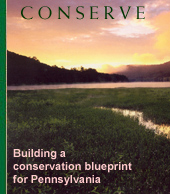 A Message from WPC President
A Message from WPC President
Dennis McGrath
We are excited to bring you this issue of CONSERVE. In it we outline a conservation blueprint for Pennsylvania, our first iteration of a long-term vision for conservation success across eight regional landscapes. The blueprint is a science-and- information driven tool that is based on data gathered during the past 30 years. We see it as our path into the future.
Accompanying the maps you will also find information about why we must work in these places and what we must do to conserve them. Because the blueprint is dynamic, we fully expect to adapt it as new information and knowledge is developed.
As you might expect, the information and knowledge that went into developing the blueprint came from many people, institutions and agencies in both the public and private sectors. We simply can’t do justice to them all in this short space, but would be remiss if we didn’t mention in particular the financial and intellectual investments made by Pennsylvania’s Department of Conservation and Natural Resources, Department of Environmental Protection, Fish and Boat Commission, and Game Commission.
During the past months, we have made several adjustments to implement blueprint conservation, from using it to establish our 2006 budget, to the placement of our project offices and staff in the field. More than anything, however, is our ability to now set forest and water conservation objectives and monitor our progress toward them. For example, during the next three years we have set ambitious goals to protect 20,000 - 25,000 acres of land and 400 miles of streams and rivers, all part of the blueprint. |
How will we use the blueprint in the months and years to come?
- First, we will use it to establish priorities.
- Second, we will measure our progress and success against it.
- Third, it will drive the allocation of our time and funding.
- Fourth, we will develop and implement strategies to eliminate or reduce the threats affecting the places within the blueprint.
Our next challenge is to develop the correct strategies to achieve these goals. Certainly land acquisition is a time-tested way to protect land. Yet there are other tools we hope to develop and employ, such as the expanded use of conservation easements. We look forward to addressing these in the future. In the meantime, thank you for your support and commitment; it is that, after all is said and done, that counts the most and is truly indispensable.
Go to the lead article, Building a Conservation Blueprint.

